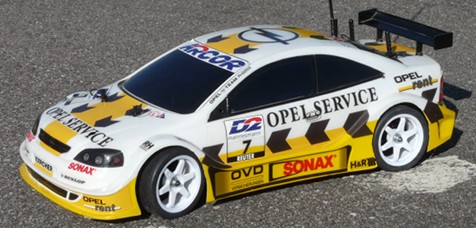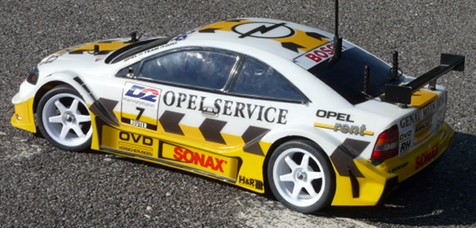TL-01 chassis: choosing the gear ratio
With such a powerful motor, it is important to carefully consider the gear ratio. Choosing a gear ratio depends on two things:
- the track layout : short ratio when there are many low speed corners, long ratio if it is a fast track.
- the motor "convenient" gear ratio: either it is written on the manual or you can forget about it.
The perfect gear ratio is the one that best combines the two factors: too short on a fast track will make the motor overheat due to being almost full time at its maximum load (the car will have a poor top speed). On the contrary, a too long ratio on a low speed track will make the motor overheat due to making too much efforts to move the car. The car will have poor throttle response. The best is obviously a motor working at its best ratio range and a track layout allowing the same chassis gear ratio. This is also why, apart from their inner qualities, all motors are not the same: thanks to timings (position of the brushes relative to the magnets), a motor can have more or less torque or rpm. This is one of the differences between the SuperStock RZ (speed) and SuperStock TZ (torque) from Tamiya.
With brushless motors, some motor manuals give the gear ratio range. Being brushless, you can't modify the motor timings: its the controller that can fix this setting. The controller can make the electric intensity sent to the motor vary in a non linear way relative to the radio throttle command. This is the role of the program card that comes with the EZrun combo. To be honest, I will stick to the stock settings.
Caution: here again, I tried to make the explanations simple and had no consideration for many very important factors. If the brushless technology is very complex on the motor side, it is even more complex on the controller side. To make things clear, the controller settings could contradict all the above and still provide an excellent and reliable combo. This means that a deep modification in the controller settings can lead to very serious problems, from a combo that doesn't work anymore or that works very badly, to a controller going on fire due to overheat. As of today, only the manufacturers seems to really understand how the whole thing works: so the best is to choose a complete motor- controller set, to carefully read the manual, especially security warnings. And just stick to the factory setups.
Well, I still need to find the correct gear ratio for my TL-01 chassis. As mentioned above, the good ratio depends both on the track layout (fast for the one I know) and my EZrun combo (which manual remains speechless about the motor ratio range). Well... looks like I'm walking with sunglasses in a coal mine by a foggy moonless night ![]() . Since I don't know many things, the best is to apply the Occam's razor principle. So let's be basic:
. Since I don't know many things, the best is to apply the Occam's razor principle. So let's be basic:
| Motor pinion |
Standard ratio |
Speed Tuned (ref 53342) |
| 19T | 7.96 | 5.95 |
| 21T | 7.20 | 5.39 |
| 23T | 6.57 | 4.92 |
These are the standard and optional gear ratios on the TL-01 chassis. With the stock 540 Mabuchi motor, the 19T motor pinion will be used on very slow tracks. The TL-01 manual recommends the 23T pinion with the Sport Tuned motor, the 21T with the Dyna-Run Stock (20T) and the 19T with the Acto-Power (15T) or the Dyna-Run Special (13T). Conclusion: don't even think about the Speed Tuned option with my EZrun since it only suits the stock 540 Mabuchi. Next conclusion: the more powerful motor (high rpms), the less teeth on the motor pinion. Since my EZrun is about the same as an 18-19T brushed motor, the result of all this is obvious: go for the 19T motor pinion.
That's it: big problem, easy solution ![]() . This is only logics and eliminating as many parameters as possible: might not be academic, may be wrong due to the number of parameters that I left over, but the result should be correct.
. This is only logics and eliminating as many parameters as possible: might not be academic, may be wrong due to the number of parameters that I left over, but the result should be correct.
Verdict at the track.
First runs
I went to the closest track for a quick test run: conditions were not the best since this outside track was very dirty. So before plugging everything, I preferred to shoot the model in order to have a proof of its initial state.


The first feeling is that my setup is pretty good: set to the minimum, I still can handle it, especially at the start and when re-accelerating. But when the controller give the rpm their freedom, the speed is somewhat crazy.
My main problem was to transmit the power to the ground: I never skid that much. Might be the tires (but I used Tamiya Type-A with hard inserts) but the dirty track must be guilty. Proof is that after only one pack, my chassis is dirty like my Baja King's was after a dirt session. OK, the two below shot may prove I used my car like a lawn mover, but this can't explain everything.


A later run was made using a slightly different setup, especially on brakes. In fact, the brake force is directly proportional to the motor power, that is with tons of power, too much for the tires. This is why I changed to "drag brake force" (motor brake) to 0% because releasing the throttle made the car immediately skid.
Last update 20/01/2014: After many runs enduring my driving mistakes while I was learning how to handle powerful motors, I finally decided to sell my TL-01. Of course, the nice bodyshell you see in this review did not last long in this condition, but it could still serve. As for the chassis, it never suffered the slightest brake or problem: the TL-01 is bulletproof, just perfect for learning how to drive, including when powerful motors are installed.
Now that my driving skills are better (not perfect: I said better ![]() ), I feel more confident when driving my TA-04 TRF and TB-03 so I didn't have the need for the TL-01 anymore.
), I feel more confident when driving my TA-04 TRF and TB-03 so I didn't have the need for the TL-01 anymore.
Related articles
- 58301 Baja King - TL-01B
- Electronic speed controllers, ESC, Mechanical Speed Controllers, MSC, motors




